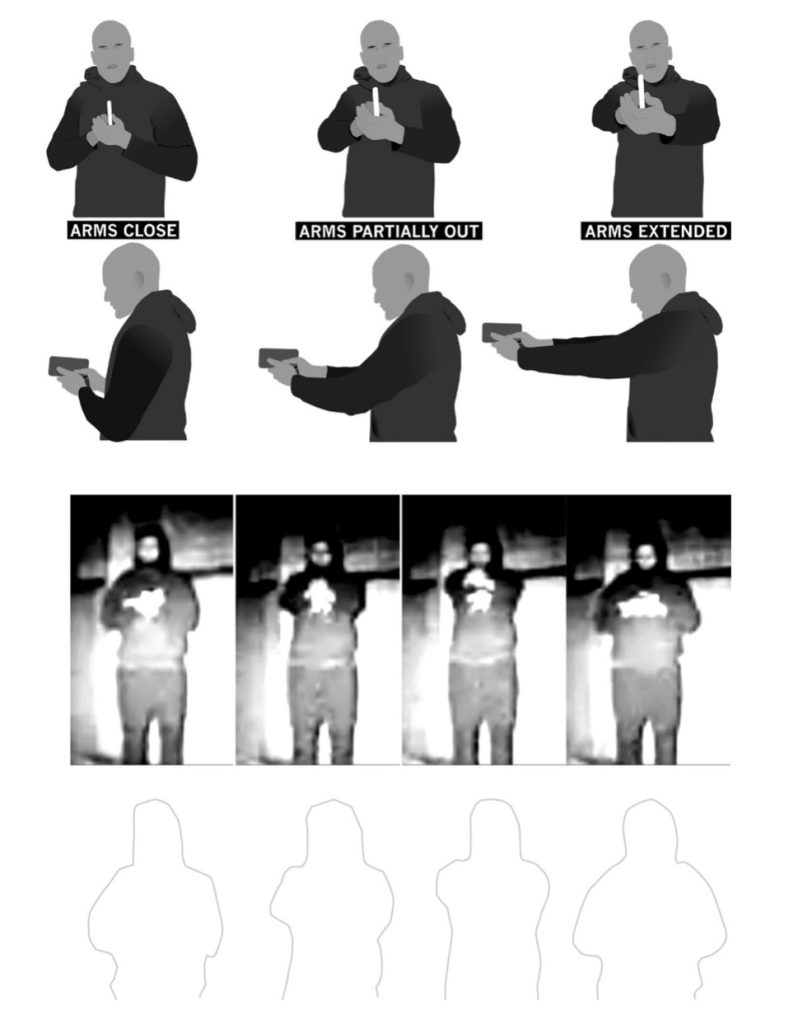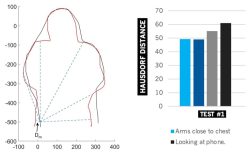
Features
Technology
The shape of intention
July 26, 2022 By Geoffrey T. Desmoulin
 Photo credit: GTD Scientific Inc.
Photo credit: GTD Scientific Inc. Current forensic investigations often involve analysis of video evidence, which may have limited resolution and clarity, particularly when acquired under poor lighting conditions or when objects of interest are at a distance. A recent case involving a nighttime police shooting of a suspect illustrates how some relatively simple image processing techniques can be used to resolve ambiguity in body worn camera images.
In this case, the officers mistook a mobile phone for a firearm. Fearing that they were being targeted at close range, they used deadly force to subdue the suspect. The principal question in the investigation was whether the officers’ judgment of the intention of the subject could be substantiated.
Figure 1 illustrates three postures which could be interpreted as a suspect holding a mobile phone in a shooting stance. These shooting stances are further illustrated in a nighttime video re-enactment shown in the bottom rows of the figure, along with a fourth posture in which the subject is looking down at the phone, rather than deploying it like a firearm. One feature which distinguishes these postures from each other is the shape of the outline of subject, as depicted in the bottom row. The key to the forensic investigation was determining whether the suspect had adopted an aggressive shooting posture, which could have been interpreted as a threat.
Because the two officers thought that the suspect was armed, they quickly took cover. Their body worn cameras only briefly captured the suspect in the distance. Since the lighting conditions were poor, single frames from the video lacked sufficient clarity to determine whether the suspect was posed in a shooting stance. However, there were 10 consecutive frames in one of the videos in which the suspect could be seen. The suspect appeared to be stationary and there was relatively little camera movement, providing an opportunity to average the images.
Image averaging is a technique long used by night sky photographers to enhance the brightness of stars and nebulae, adding detail to the image without artificial manipulation of the image.
Although there was insufficient detail in the averaged image to clearly see the suspect’s hands, the suspect’s outline was sufficiently distinct to allow for shape similarity analysis of his upper body. One measure of shape similarity, which is relatively straightforward to implement and has the desirable properties of uniqueness and robustness to image deformation and noise, is the Hausdorff distance. The Hausdorff distance is determined by first measuring the distance from every point on the outline of a reference object to every point on the outline of the object to which it is being compared. At each point on the reference object, the minimum distance to the comparison object is determined. The largest value of this set of minimum distances represents the Hausdorff distance. The smaller the Hausdorff distance, the more similar the two shapes.

Photo credit: GTD Scientific Inc.
The left panel of Figure 2 illustrates the process of calculating the Hausdorff distance as applied in comparing the outlines illustrated in Figure 1 to the reference outline obtained from the averaged image. The reference outline is shown in black and one of the comparison outlines is shown in the red. The dashed blue lines illustrate distances from one point on the reference outline to several points on the comparison outline. The dashed line labeled Dm represents the minimum of all distances from the comparison outline to that point on the reference outline. For every point on the reference outline there is a minimum distance to the comparison outline. The Hausdorff distance is the largest value among these minimum distances.
The right panel in Fig. 2 shows the result of the similarity analysis for the four postures shown in Fig. 1. The result is that the posture representing looking down at the phone had the largest Hausdorff distance, making it much more likely that the suspect had adopted a threatening shooting stance, pointing his mobile phone at the officers.
An important feature of image averaging is that it did not involve any manipulation of the original images. It simply removed noise in the image, which allowed the suspect’s outline to be drawn more accurately. Shape similarity analysis provided a validated, quantitative method to distinguish between different intentions and an objective means of substantiating the officers’ perception of danger.
References
- Huttenlocher DP, Klanderman GA, Rucklidge WJ. (1993) “Comparing images using the Hausdorff distance.” IEEE Transactions on Pattern Analysis and Machine Intelligence, 15: 550-863.
- Jähne B. (2005) “Chapter 10: Pixel Processing.” Digital Image Processing 6th Edition, Springer, pp. 268-269.
- Oliver WR. (1988) “Image processing in forensic pathology.” Clinics in Laboratory Medicine, 18: 151-180.
- Veltkamp RC, Latecki LJ. (2006) “Properties and performance of shape similarity measures.” In: Batagelj V, Bock HH, Ferligoj A, Žiberna A. (eds) Data Science and Classification. Studies in Classification, Data Analysis, and Knowledge Organization. Springer, Berlin, Heidelberg.
Geoffrey T. Desmoulin, PhD., RKin., EngL., Principal of GTD Scientific Inc. in North Vancouver, holds two degrees in both Engineering Sciences and Kinesiology. He can be reached at gtdesmoulin@gtdscientific.com.
Print this page